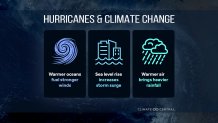A hurricane is an amazing weather phenomenon. It begins with a few clusters of thunderstorms. If conditions are ripe, those few thunderstorms can explosively develop into a major hurricane within a matter of a few days.
Warmer sea surface temperatures, due to climate change, are the biggest influence on hurricanes. NASA estimates 90% of the excess heat in the atmosphere is absorbed by our oceans.
Stream Connecticut News for free, 24/7, wherever you are.
Warmer sea surface temperatures can help hurricanes form and rapidly intensify. This can lead to heavier rainfall upon landfall, as the warmer atmosphere is able to hold more moisture. Rising sea levels increase the risk for our coastal towns and cities to experience flooding and storm surge.

Get top local Connecticut stories delivered to you every morning with the News Headlines newsletter.
We also know that hurricanes are getting stronger, faster. There is a term in meteorology referred to as "extreme rapid intensification." This happens when a tropical system's maximum wind speed increases at least 58 miles per hour in 24 hours. This is a rare occurrence, but has been happening more often in recent years, according to Climate Central.

Due to the warmer ocean temperatures, the Atlantic Ocean is able to generate a named storm earlier and later in the hurricane season. It doesn't happen every year, but when the climate averages were updated in 2020, from 2010, the average number of tropical storms in a single season rose from 12 to 14, and the hurricane average rose from 6 to 7.
This doesn't mean Connecticut will get more hurricanes in the future. It just means that when a tropical storm or hurricane approach our shoreline, the storm will have a higher chance of delivering greater storm surge, heavier rainfall, and stronger wind.

There are unknowns, however, when it comes to climate change's impact on hurricanes.
Changing Climate
In-depth coverage of our changing climate and environmental issues
Our atmosphere is warming, but it is also warming above ground level. This upper-level warming can stabilize an air mass, making it more difficult for a hurricane to form. We don't fully know how much this upper-level warming is affecting hurricane growth.
Also, many hurricanes form from thunderstorms in Africa, but we don't know if/how those rain patterns in Africa are changing, resulting in differences in Atlantic Ocean hurricanes.
Finally, the changing jet stream can affect wind shear. Hurricanes don't like wind shear, because it tears them apart. We're still trying to conclude how changing jet stream patterns affect hurricanes.
At the end of the day, it's important to be prepared for a hurricane or tropical storm, even if you're inland and away from the shoreline. Build your preparedness kit, review your severe weather safety plan with your family, and make sure your home, vehicles, or personal property is protected and ready!



